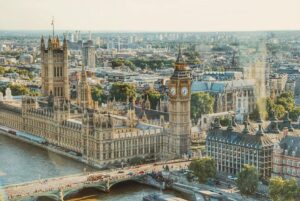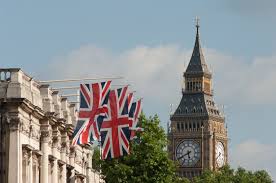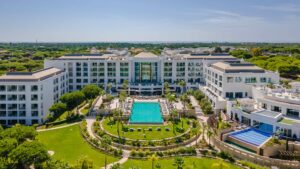There was a point in time, not too long ago, when a leisurely car trip from England to Portugal seemed impossible. Lockdowns, quarantines, PCR and lateral flow tests, vaccinations, and all the rest of that strange inferno we had all descended into seemed never-ending and impossible to overcome.
But patience and perseverance won out. On August 25, Helga and I got in our car in London, where we had spent the summer (avoiding all the excessive Algarve heat), and drove to France, through the “Chunnel”, with an absolute minimum of bother.
At the border, the French were only interested in our EU digital certificates, proving we had been vaccinated at least two weeks before our departure. This certificate is called a “pass sanitaire” and it must be produced absolutely everywhere one goes in France (even just for a cup of coffee). Masks were also de rigueur.
Our goal, after a long period of stasis, was to slowly drive through France, visiting a number of places in Normandy, the Loire and the Dordogne, staying in lovely château hotels and eating and drinking well. Essentially, we wanted to rekindle the joys of travel.
And we succeeded! After leaving the Chunnel, we drove south to the Alençon area in Normandy, where our first stop was a visit to the Château de Carrouges, an imposing structure dating from the 14th century, situated in beautifully landscaped grounds and surrounded by a moat. Much of the original fortress was destroyed by the English in 1367 in the Hundred Years’ War. This is an enormously impressive château and a reminder that there are a huge number of little-known but well worthwhile sites in France.
We stayed in the Château de Sarceaux. Frankly, calling it a château is a misnomer – it is really a lovely country house. Dinner was outside, in the front garden.
On day 2, we drove south to the Loire (about 170km), where we first visited Langeais. The imposing château, located smack in the centre of the pretty town, was founded in 992 but, after being destroyed in the Hundred Years’ War, was rebuilt about 1465 by Louis XI. Anne of Brittany was married to Charles VIII on December 6, 1491, in the Great Hall, permanently uniting Brittany and France.
After an afternoon visit to the Château de Gizeux, an enormous 250-metre-long structure north of Langeais, we found our night’s lodging at the Domaine du Château d’Hommes.
Day 3 was a splurge of Loire châteaux, starting with the beautiful jewel at Azay-Le-Rideau, built in the early 1500s on the ruins of an earlier structure burned down by Charles VII in 1417. Set on an island in the middle of the Indre River, this picturesque example of early French renaissance architecture is one of the most popular Loire châteaux.
From Azay, we drove along the Indre to the Château d’Ussé. Famed for its picturesque aspect and dominant positioning on the Indre, Ussé was built largely in the 1440s. Charles Perrault often visited Ussé and had the castle in mind when he wrote his “Sleeping Beauty” fairy tale. And Ussé inspired Walt Disney in the creation of many of his castles. It is almost the only Loire château still privately owned, by the family of the 7th Duc de Blacas.
From Ussé, we drove the short distance to Chinon, on the banks of the Vienne River, where we stopped for lunch al fresco in the town square below the dour and imposing walls of the very old Forteresse Royale et Château de Chinon. Although parts of the structure date from the 10th century, its real period of fame began when Henry II of England took the castle from his brother Geoffrey in 1156 and used it as a residence, building most of the structure we see today. Henry died in 1189 and was buried at nearby Fontevraud Abbey. Philip II of France conquered the castle in 1205 and it has been in French hands since then.
With Henry in mind, we then drove to nearby Fontevraud Abbey, founded in 1101. It was unique at the time in that the monastic community consisted of both men and women (in separate quarters), all subject to the authority of the Abbess of Fontevraud. Henry II, his wife Eleanor of Aquitaine (one of the most powerful and rich women of the era) and their son Richard the Lionheart were all buried in the Abbey – unfortunately and sadly, today they are commemorated only by rather shabby-looking plaster casts of their original tombs.
This had been a busy day, so we were glad to trundle the few kilometres south to our next hotel, La Gourmandine, in Châtellerault. The hotel was very comfortable, but its best feature was its proximity to one of our favourite restaurants, La Ferme Saint Jacques, where we had a lovely, relaxed dinner on the terrace.
Day 4 required a bit more driving – about 300km down to the Dordogne. After skirting the Lascaux Caves, which we didn’t have time to stop for (but which are well worth a visit), our first destination was Sarlat, a very pretty medieval town said to be one of the most typical and well-preserved representatives of 14th century France. The main feature the day we arrived (a Saturday) was Sarlat’s well known, and very active, street market. We had done enough castle hopping in the past few days, so we were happy to leisurely browse the stalls.
From Sarlat, we drove just a bit more south to find our hotel L’Esplanade in Domme, a very small and well preserved fortified medieval town (Bastide) located on a rocky promontory 150m above the Dordogne River, founded in 1281 by Philip III (the Bold). The street views of golden yellow stone are gorgeous, but the biggest attraction is the extraordinarily breathtaking view of the Dordogne River valley down below. Dinner was again al fresco, in the Auberge de la Rode in the square of the same name, and was a delicious mélange of Périgord specialities.
The Dordogne River valley is one of the natural beauty spots of France and, in a normal year, is jammed with tourist traffic. This not being a normal year, we had clear, open roads and were able to enjoy one of France’s most interesting and unusual sights – the village of Rocamadour. This small village has been built literally on the side of a 120m cliff above the Alzou, a tributary of the Dordogne. It was a site of religious significance in the early Middle Ages and boasted a number of miracles that attracted pilgrims. Its main interest today is the sight of this almost totally vertical village clinging to its cliff face.
We wanted to stop in Cahors but didn’t have time as we had been invited to a lovely Sunday lunch at the house of friends in the nearby countryside. After a most delightful and relaxing two hours, we were back on the road, driving all the way to Urrugne, just south of Saint Jean de Luz on the Franco-Spanish border. Our hotel was the imposing Château d’Urtubie, a fortified castle in the same family since its construction in 1341. Dinner was in the nearby Ferme Lizarraga, another of our favourite restaurants, this one serving up farm fresh Basque specialities.
Our long trip through Spain was broken by a night in Ávila, known for its complete and prominent medieval walls, but this was a stop of convenience (and a great dinner in the Parador), not of sight-seeing, as we were by then anxious to get on home. Which we did on Tuesday, the next day.
The trip had been a much-needed and very welcome reminder that the world is waiting for us out there, as soon as we can get our lives back to “normal”.
By Larry Hampton
Photos: Larry Hampton





in the centre of the town

































